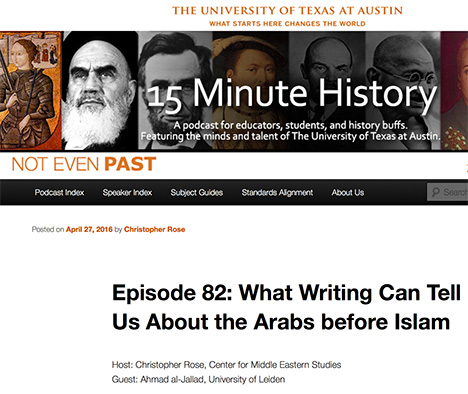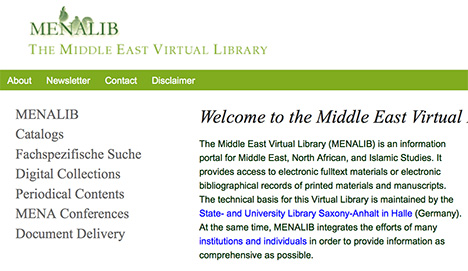Onomasticon Arabicum (OA) is a long-living database project. This new online-version informs on more than 15000 scholars and celebrities from the first Muslim millenary. Its entries in Arabic are compiled from ancient biographical dictionaries, a veritable treasure of Islamic culture. Crossed search allows separate interrogation on any of the different elements of the Arabo-Muslim names, dates and places, reconstructing the identity of a person, trace ways of knowledge transmission and frame historical contexts.
Category Archives: Languages
Arabic Writing before Islam
In most world history survey courses, Arabia is introduced for the first time only as backstory to the rise of Islam. We’re told that there was a tradition of oral poetry in Arabic, a language native to central Arabia, and that the Qur’an was the zenith of this oral tradition. New evidence, however, suggests that Arabia was linguistically diverse, that the language we’ve come to know as Arabic originated in modern day Jordan, and that the looping cursive writing system that’s become the language’s hallmark wasn’t the original system used to write it. What to make of all this?
Guest Ahmad al-Jallad co-directs archaeological/epigraphic projects in Jordan and Saudi Arabia, uncovering new inscriptions thousands of years old, and shares his research that’s shedding new light on the writings of a complex civilization that lived in the Arabian peninsula for centuries before Islam arose.
Click here to hear the broadcast.
Advanced Course in Arabic Manuscript Studies
The Islamic Manuscript Association, in cooperation with Cambridge University Library and the Thesaurus Islamicus Foundation, is pleased to announce an advanced short course in manuscript studies, entitled Scholars, Scribes, and Readers: An Advanced Course in Arabic Manuscript Studies, which will be held at Cambridge University Library from 6 to 10 June 2016.
This intensive five-day course is intended for researchers, librarians, curators, and anyone else working with Islamic manuscripts. As an advanced course, it is particularly aimed at those who already have some experience in Islamic codicology and palaeography and all participants must have a good reading knowledge of Arabic. The course will focus on Arabic-language manuscripts from various regions, including historical Turkey, Iran, and India. It is hoped that this advanced course will allow participants to gain greater exposure to and familiarity with the vast array of practices encountered in Arabic manuscripts.
The workshop will consist of three days of illustrated, interactive lectures on selected manuscripts and two days of hands-on sessions focusing on a selection of manuscripts from the Cambridge University Library collection. The manuscripts selected for presentation by the instructor cover the whole range of scribal practices encountered in a variety of subjects/genres, geographical regions, and historical periods (see the programme for details).
Continue reading Advanced Course in Arabic Manuscript Studies
MenaLib Site
MENALib is a major resource for find e-texts, manuscripts, etc.
Mountains of Central Asia Digital Dataset
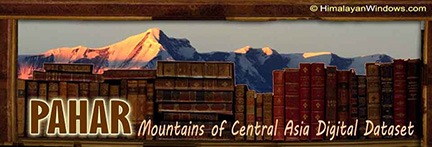
This Mountains of Central Asia Digital Dataset (MCADD) consists of a collection of books, journals and maps related broadly to the Himalayas and its outlying attached ranges including the Hindu Kush, the Karakorams, the Pamirs, the Tian Shan and the Kuen Lun as well as the Tibetan highlands and the Tarim basin. These materials are housed in this site, and are freely available for personal non-commercial use and downloading.
Some of this material was originally downloaded from the Google Books website, but often this material from Google has been augmented by the addition of maps and other oversize materials that were excluded when the original Google scans were done and/or the addition of missing pages. For example, the Google scans of the 50 volumes of the Royal Geographical Society Journal, published between 1830 and 1880 do not include any of the oversize maps—these maps have all now been scanned and some 450 maps added in their proper location to each of the journal volume pdf files on the PAHAR website.
Various aids to searching specific topics, such as indexes of articles related to the MCADD geographic area (Himalaya, Tibet and Central Asia) have also been prepared for the more prolific journals, such as those of the Royal Geographical Society, the Royal Central Asian Society, and the Asiatic Society of Bengal. Continue reading Mountains of Central Asia Digital Dataset
Library of Congress on the Near East

The Library of Congress has a very nice website with online resources regarding its collection of Near Eastern materials.
Otto-mania
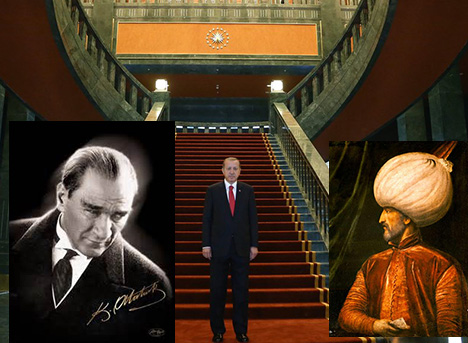
Turkey in the Ergogan era is undergoing an interesting change. Now it seems the course is less about economically reinvading Europe than going on a kind of Ottoman-matic pilot course. A committee has recently announced a call to have mandatory teaching of Ottoman in Turkish high schools. “According to the proposal, Ottoman Turkish should be compulsory because people in Turkey are not able to read documents from Ottoman times, including the epitaphs of their forefathers. The proposal argues that Ottoman Turkish is necessary to keep Turkish people’s ties with their past strong,” notes a Turkish paper. As a student of history in the region, I am delighted that there should be such an interest in promoting the study of Turkey’s Ottoman past. But given that Ataturk must be rolling over in his mausoleum, one wonders about the political symbolism in such a revival.
President Erdogan has come under considerable criticism at home and abroad for his support of the Muslim Brotherhood, a more conservative brand of Islam than many Turks favor, and his apparent failure to stem the tide of Western and Arabic recruits for the ISIS/ISIL/IS caliphate in the making (and unmaking) to his south. Now that there is a new Ak Saray (White Palace) for President Erdogan with 1,000 rooms on 150,000 sq. m of former forested land and at a cost now nearing $615 million, the idea of reviving the Ottoman caliphate is clearly waiting in the wings (and that saray has a lot of wings). The Middle East still has its kings, sultans and emirs, even if most of the dictators have bit the dust. So can Ak Saray blend with the Topkapi to form a new re-Ottomanized Turkey? Continue reading Otto-mania
Making Palestinian Arabs invisible
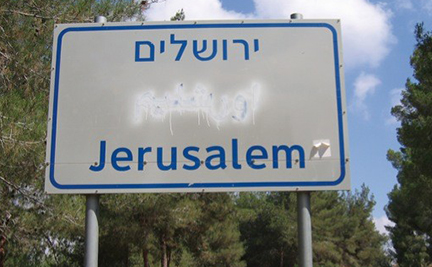
The Irony of Erasing Arabic
Making Hebrew Israel’s Only Language Ignores History
By Liora R. Halperin, Forward, October 06, 2014
In late August, a group of Knesset members from the right flank of the Likud party, Yisrael Beiteinu and the Jewish Home party proposed a bill that would make Hebrew the only official language of Israel, annulling a requirement in existence since the British Mandate period that all official documents be published in Arabic as well as in Hebrew. Similar bills to eliminate or demote the official status of Arabic were proposed in 2011 and 2008. Critics have pointed out that this bill is part of a broader effort to affirm the “Jewish†character of the state (as opposed to its democratic character) by enshrining Jewishness into Israel’s basic laws. Israeli President Reuven Rivlin, for one, has spoken out against it.
A historical perspective is worth adding to the discussion, one that highlights a contradictory Zionist view of language that has existed since the British ruled Palestine: As Zionists advocated forcefully for the very principle of national language rights, they fantasized about a society in which there would be no national competitors to Hebrew. Israel still is navigating between these two positions. Continue reading Making Palestinian Arabs invisible

